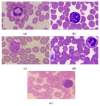White Blood Cell Classification Using Texture and RGB Features of Oversampled Microscopic Images
- PMID: 36360571
- PMCID: PMC9691098
- DOI: 10.3390/healthcare10112230
White Blood Cell Classification Using Texture and RGB Features of Oversampled Microscopic Images
Abstract
White blood cell (WBC) type classification is a task of significant importance for diagnosis using microscopic images of WBC, which develop immunity to fight against infections and foreign substances. WBCs consist of different types, and abnormalities in a type of WBC may potentially represent a disease such as leukemia. Existing studies are limited by low accuracy and overrated performance, often caused by model overfit due to an imbalanced dataset. Additionally, many studies consider a lower number of WBC types, and the accuracy is exaggerated. This study presents a hybrid feature set of selective features and synthetic minority oversampling technique-based resampling to mitigate the influence of the above-mentioned problems. Furthermore, machine learning models are adopted for being less computationally complex, requiring less data for training, and providing robust results. Experiments are performed using both machine- and deep learning models for performance comparison using the original dataset, augmented dataset, and oversampled dataset to analyze the performances of the models. The results suggest that a hybrid feature set of both texture and RGB features from microscopic images, selected using Chi2, produces a high accuracy of 0.97 with random forest. Performance appraisal using k-fold cross-validation and comparison with existing state-of-the-art studies shows that the proposed approach outperforms existing studies regarding the obtained accuracy and computational complexity.
Keywords: Chi-squared; SMOTE; leukemia; texture features; white blood cells classification.
Conflict of interest statement
The authors declare no conflict of interests.
Figures










Similar articles
-
White blood cells classification using multi-fold pre-processing and optimized CNN model.Sci Rep. 2024 Feb 12;14(1):3570. doi: 10.1038/s41598-024-52880-0. Sci Rep. 2024. PMID: 38347011 Free PMC article.
-
WBC-based segmentation and classification on microscopic images: a minor improvement.F1000Res. 2021 Nov 17;10:1168. doi: 10.12688/f1000research.73315.1. eCollection 2021. F1000Res. 2021. PMID: 35399225 Free PMC article.
-
Improving prediction of blood cancer using leukemia microarray gene data and Chi2 features with weighted convolutional neural network.Sci Rep. 2024 Jul 7;14(1):15625. doi: 10.1038/s41598-024-65315-7. Sci Rep. 2024. PMID: 38972881 Free PMC article.
-
Predicting the Cochlear Dead Regions Using a Machine Learning-Based Approach with Oversampling Techniques.Medicina (Kaunas). 2021 Nov 2;57(11):1192. doi: 10.3390/medicina57111192. Medicina (Kaunas). 2021. PMID: 34833410 Free PMC article.
-
DeepSSPred: A Deep Learning Based Sulfenylation Site Predictor Via a Novel nSegmented Optimize Federated Feature Encoder.Protein Pept Lett. 2021;28(6):708-721. doi: 10.2174/0929866527666201202103411. Protein Pept Lett. 2021. PMID: 33267753
Cited by
-
An Explainable Vision Transformer Model Based White Blood Cells Classification and Localization.Diagnostics (Basel). 2023 Jul 24;13(14):2459. doi: 10.3390/diagnostics13142459. Diagnostics (Basel). 2023. PMID: 37510202 Free PMC article.
-
Automated Battery Making Fault Classification Using Over-Sampled Image Data CNN Features.Sensors (Basel). 2023 Feb 8;23(4):1927. doi: 10.3390/s23041927. Sensors (Basel). 2023. PMID: 36850526 Free PMC article.
-
A dataset of drip patterns for teaching and research purposes in forensic bloodstain pattern analysis.Data Brief. 2025 Jan 31;59:111352. doi: 10.1016/j.dib.2025.111352. eCollection 2025 Apr. Data Brief. 2025. PMID: 39996050 Free PMC article.
-
White blood cells classification using multi-fold pre-processing and optimized CNN model.Sci Rep. 2024 Feb 12;14(1):3570. doi: 10.1038/s41598-024-52880-0. Sci Rep. 2024. PMID: 38347011 Free PMC article.
References
-
- Phosri S., Jangpromma N., Chang L.C., Tan G.T., Wongwiwatthananukit S., Maijaroen S., Anwised P., Payoungkiattikun W., Klaynongsruang S. Siamese crocodile white blood cell extract inhibits cell proliferation and promotes autophagy in multiple cancer cell lines. J. Microbiol. Biotechnol. 2018;28:1007–1021. doi: 10.4014/jmb.1712.12002. - DOI - PubMed
-
- Monteiro A.C.B., França R.P., Arthur R., Iano Y. Intelligent Interactive Multimedia Systems for e-Healthcare Applications. Springer; Berlin/Heidelberg, Germany: 2022. AI Approach Based on Deep Learning for Classification of White Blood Cells as a for e-Healthcare Solution; pp. 351–373.
-
- White Blood Cell. [(accessed on 10 April 2022)]. Available online: https://www.britannica.com/science/white-blood-cell.
Grants and funding
LinkOut - more resources
Full Text Sources

